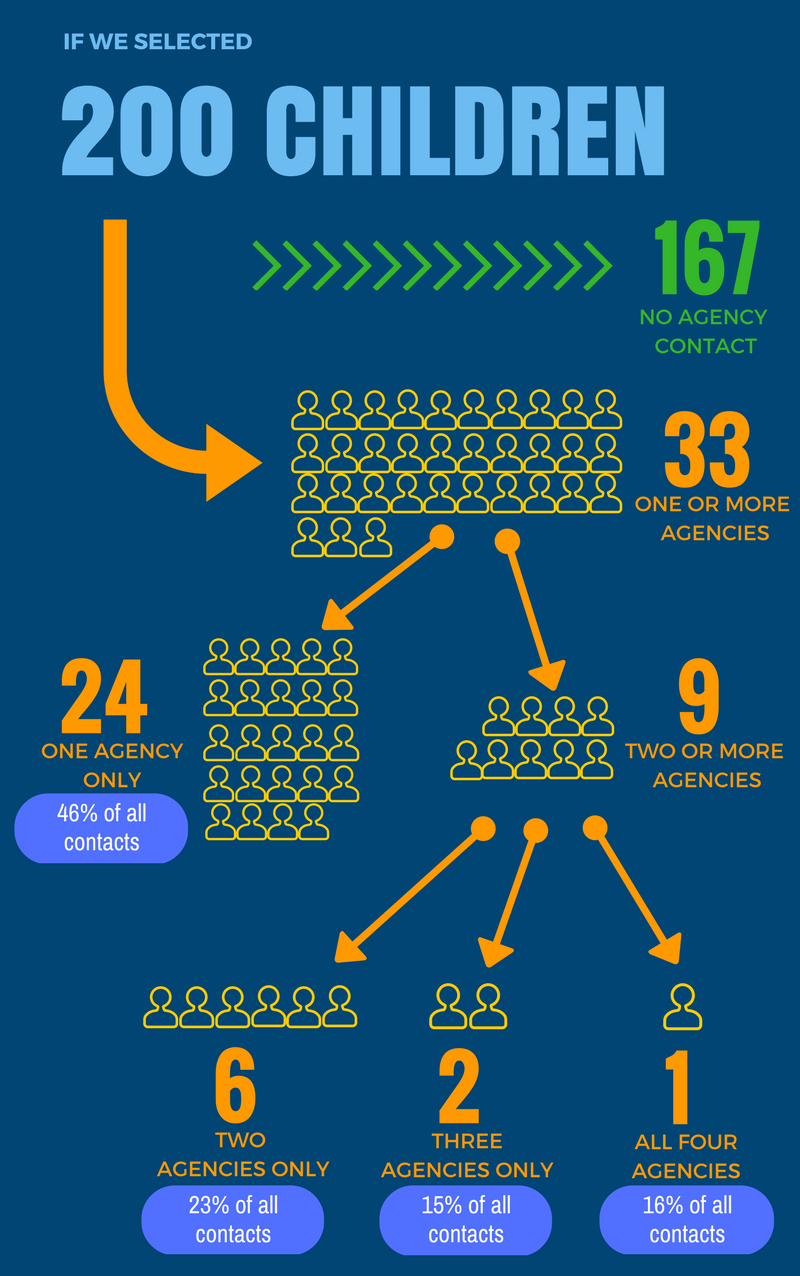This report documents the findings of a research study examining the characteristics and patterns of service use by a cohort of young people born between 1994-1997 who used four government services - child protection, mental health, courts, and corrections up until 18 years of age.
Key Findings:
Young people in contact with multiple agencies comprise a relatively small group of ‘clients’, who have a disproportionately high level of service use or contact.
Among the 168,201 young people in the eligible population, almost 1 in 6 young people (16%) had at least one contact with an agency. Compared to this, 2,579 young people (1.5%) had contact with three or more agencies. These young people accounted for almost one third (31%) of service contacts with the agencies.
There were 859 young people (0.5%) who had contact with all four agencies. These young people, referred to throughout the Report as ‘shared clients’ accounted for 16% of service contacts.
These shared clients constitute a very high needs group that place a heavy burden on services. Figure 1 illustrates the extent to which clients are ‘shared’ across the four agencies, and the high level of all service contacts accounted for by those in contact with multiple agencies.
 Figure 1: Extent of contact with multiple Government agencies in Western Australia for four agencies (Mental Health Services, Corrections, Courts, and CPFS)
Figure 1: Extent of contact with multiple Government agencies in Western Australia for four agencies (Mental Health Services, Corrections, Courts, and CPFS)
Many of the children in contact with all four agencies (the ‘shared clients’) had repeated contact with each of the agencies
Three quarters (75%) of the 859 shared clients had repeated contact with Child Protection and Family Support (two or more contacts with that agency).
Among these shared clients,
- Repeated agency contact was even more common with Mental Health Services (82%), Corrections (91%), and Courts (90%).
- Higher levels of repeated contacts (more than 10 contacts with the agency) were also common among the shared client group.
- One in five (21%) of the shared clients had more than 10 repeat contacts with CPFS.
- Almost half (44%) of the client group had more than 10 repeat contacts with each of Mental Health Services and Corrections (46% and 47% respectively), and
- Over 2 in 5 had more than 10 repeated contacts with the Courts (43%).
Of the four agencies, Child Protection and Family Support is the earliest agency contacted among young people with multiple agency contacts
Of the 859 young people in the shared client group, 700 (81%) had first contact with CPFS. This is expected as Child Protection clients are typically younger than those of the other agencies at first contact and young people in Western Australia are only dealt with by Corrections and the Courts from 10 years of age.
A further 13% first had a service contact with a Mental Health Service.
These agencies may provide a point of contact through which additional preventative strategies can be initiated with the aim of reducing subsequent mental health problems and offending behaviours.
However, it must be remembered that other agencies (not analysed in this study) may instead be first contacted (e.g. Police) but these data have not been linked.
Aboriginal people and males are over-represented among young people in contact with all four agencies
Aboriginal young people represented 48% of the shared client group. In comparison, Aboriginal young people accounted for just 9% of individuals who had contact with a single agency.
Males also made up 64% of young people in contact with all four agencies, yet comprised just 50% of young people in contact with a single agency.

